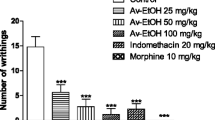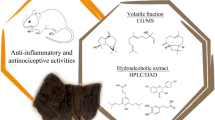Abstract
The present study was performed to explore the effect of aqueous extract of Aloe vera on behavioural parameters of pain. Pain assessment was performed by the tail-flick and formalin tests. A. vera (100 mg/kg, per oral (p.o.)) produced an insignificant decrease in the pain response in the tail-flick and formalin tests. Moreover, A. vera (200 and 400 mg/kg, p.o.) did not have significant effect on the tail-flick test. However, A. vera (200 and 400 mg/kg, p.o.) significantly decreased the second phase of the formalin-induced pain. Thus, these findings suggest that A. vera exerts its effect by a peripheral mechanism of action rather than central.


Similar content being viewed by others
References
Das, S., B. Mishra, K. Gill, M.S. Ashraf, A.K. Singh, M. Sinha, S. Sharma, I. Xess, K. Dalal, T.P. Singh, and S. Dey. 2011. Isolation and characterization of novel protein with anti-fungal and anti-inflammatory properties from Aloe vera leaf gel. International Journal of Biological Macromolecules 48: 38–43.
Rajasekaran, S., K. Sivagnanam, K. Ravi, and S. Subramanian. 2005. Antioxidant effect of Aloe vera gel extract in streptozotocin-induced diabetes in rats. Pharmacological Reports 57: 90–96.
Rajasekaran, S., K. Ravi, K. Sivagnanam, and S. Subramanian. 2006. Beneficial effects of Aloe vera leaf gel extract on lipid profile status in rats with streptozotocin diabetes. Clinical and Experimental Pharmacology and Physiology 33: 232–237.
Hamman, J.H. 2008. Composition and applications of Aloe vera leaf gel. Molecules 13: 1599–1616.
Choi, S.W., B.W. Son, Y.S. Son, Y.I. Park, S.K. Lee, and M.H. Chung. 2001. The wound healing effect of a glycoprotein fraction isolated from Aloe vera. British Journal of Dermatology 145: 535–545.
Kim, J., I.S. Lee, S. Park, and R. Choue. 2010. Effects of Scutellariae radix and Aloe vera gel extracts on immunoglobulin E and cytokine levels in atopic dermatitis NC/Nga mice. Journal of Ethnopharmacology 132: 529–532.
Penneys, N.S. 1981. Inhibition of arachidonic acid oxidation by vehicle components. Acta Dermatology and Venereology 62: 59–61.
Heggers, J.P., A. Kucukcelebi, D. Listengarten, J. Stabenau, F. Ko, L.D. Broemeling, et al. 1996. Beneficial effect of Aloe on wound healing in an excisional wound model. Journal of Alternative and Complementary Medicine 2: 271–277.
Prabjone, R., D. Thong-Ngam, N. Wisedopas, T. Chatsuwan, and S. Patumraj. 2006. Anti-inflammatory effects of Aloe vera on leukocyte–endothelium interaction in the gastric microcirculation of Helicobacter pylori-infected rats. Clinical Hemorheology and Microcirculation 35: 359–366.
D'Armour, F.E., and D.L. Smith. 1941. A method for determining loss of pain sensation. Journal of Pharmacology and Experimental Therapeutics 72: 74–79.
Abbott, F.V., K.B.J. Franklin, and F. Westbrook. 1995. The formalin test: scoring properties of first and second phases of pain response in rats. Pain 60: 91–102.
Park, M.Y., H.J. Kwon, and M.K. Sung. 2011. Dietary aloin, aloesin, or aloe-gel exerts anti-inflammatory activity in a rat colitis model. Life Sciences 88: 486–492.
Halder, S., A.K. Mehta, and P.K. Mediratta. 2012. Augmented humoral immune response and decreased cell mediated immunity by Aloe vera in rats. Inflammopharmacology. Epub ahead of print.
Park, M.Y., H.J. Kwon, and M.K. Sung. 2009. Evaluation of aloin and aloe-emodin as anti-inflammatory agents in aloe by using murine macrophages. Bioscience, Biotechnology, and Biochemistry 73: 828–832.
Vazquez, B., G. Avila, D. Segura, and B. Escalante. 1996. Antiinflammatory activity of extracts from Aloe vera gel. Journal of Ethnopharmacology 55: 69–75.
Udupa, A.L., and S.L. Udupa. 1996. Analgesic activity of Aegle marmelos and Aloe vera in mice. Indian Journal of Pharmacology 36: 74.
Cai, Y., M. Sun, J. Xing, and H. Corke. 2004. Antioxidant phenolic constituents in roots of Rheum officinale and Rubia cordifolia: structure-radical scavenging activity relationships. Journal of Agricultural and Food Chemistry 52: 7884–7890.
Matsuda, H., T. Morikawa, I. Toguchida, J.Y. Park, S. Harima, and M. Yoshikawa. 2001. Antioxidant constituents from rhubarb: structural requirements of stilbenes for the activity and structures of two new anthraquinone glucosides. Bioorganic & Medicinal Chemistry 9: 41–50.
Lee, H.Z., S.L. Hsu, M.C. Liu, and C.H. Wu. 2001. Effects and mechanisms of aloe-emodin on cell death in human lung squamous cell carcinoma. European Journal of Pharmacology 431: 287–295.
Kuo, P.L., T.C. Lin, and C.C. Lin. 2002. The antiproliferative activity of aloe-emodin is through p53-dependent and p21-dependent apoptotic pathway in human hepatoma cell lines. Life Sciences 71: 1879–1892.
Lin, J.G., G.W. Chen, T.M. Li, S.T. Chouh, T.W. Tan, and J.G. Chung. 2006. Aloe-emodin induces apoptosis in T24 human bladder cancer cells through the p53 dependent apoptotic pathway. Journal of Urology 175: 343–347.
Chen, H.C., W.T. Hsieh, W.C. Chang, and J.G. Chung. 2004. Aloe-emodin induced in vitro G2/M arrest of cell cycle in human promyelocytic leukemia HL-60 cells. Food and Chemical Toxicology 42: 1251–1257.
Author information
Authors and Affiliations
Corresponding author
Rights and permissions
About this article
Cite this article
Rathor, N., Mehta, A.K., Sharma, A.K. et al. Acute Effect of Aloe vera Gel Extract on Experimental Models of Pain. Inflammation 35, 1900–1903 (2012). https://doi.org/10.1007/s10753-012-9512-z
Published:
Issue Date:
DOI: https://doi.org/10.1007/s10753-012-9512-z




